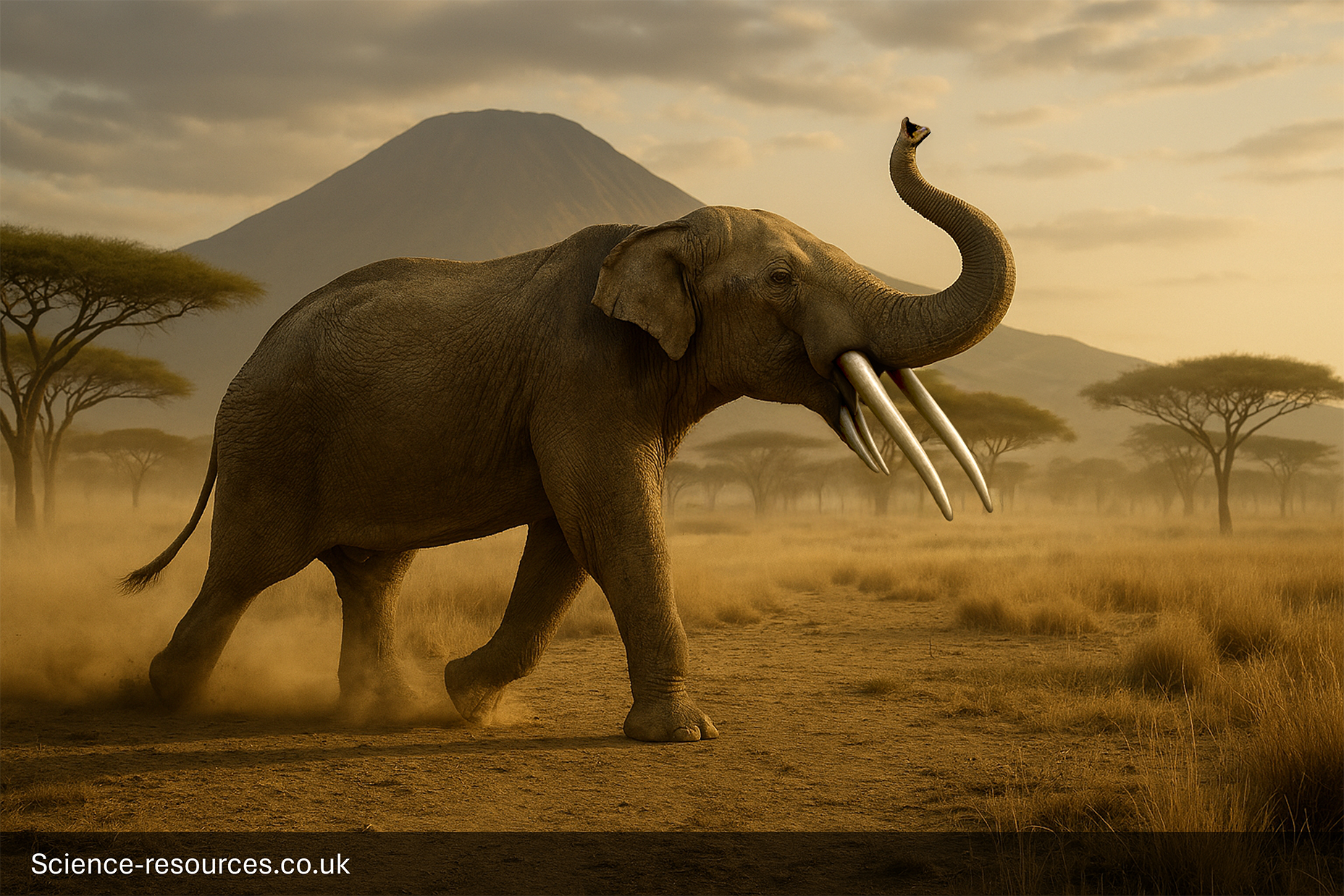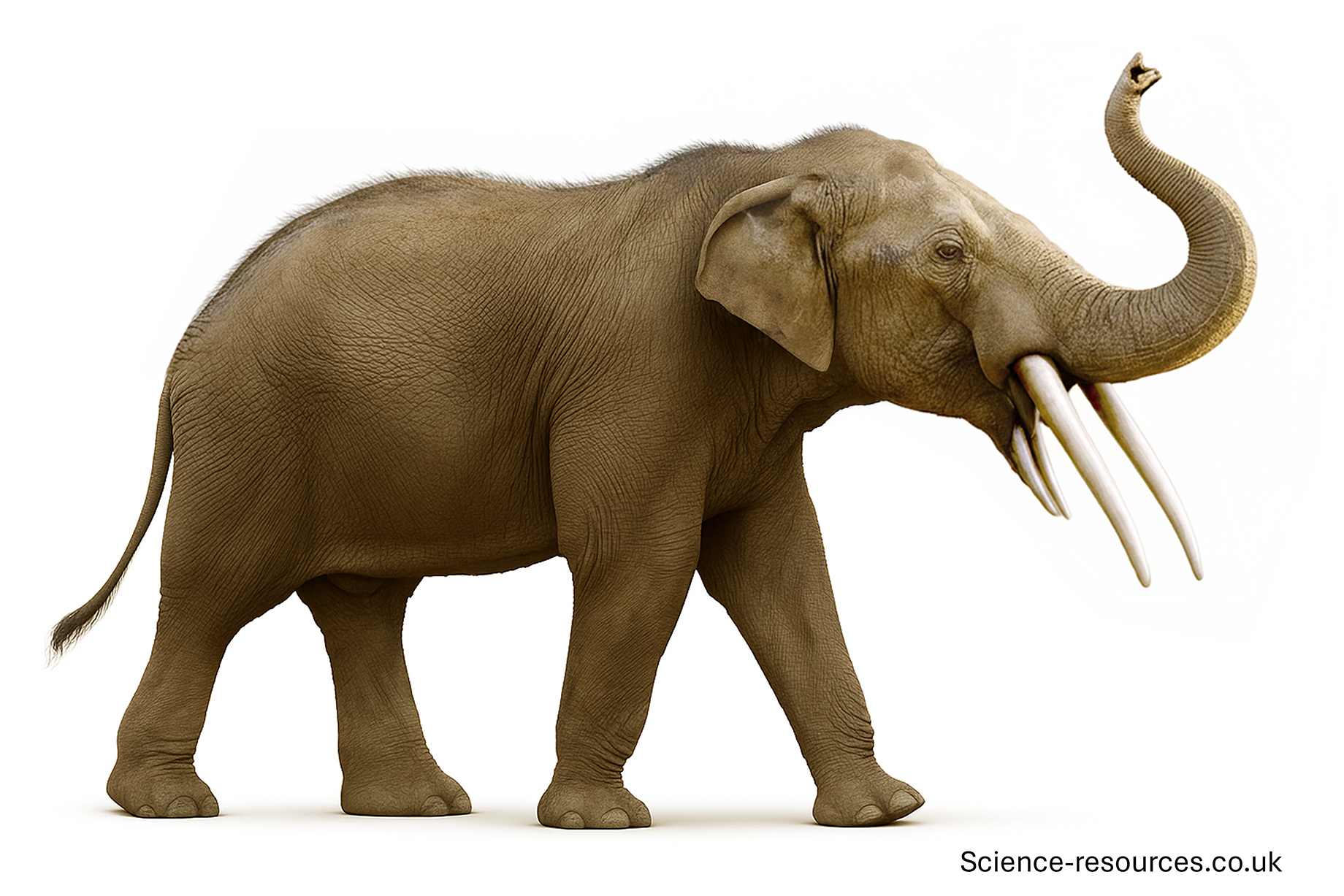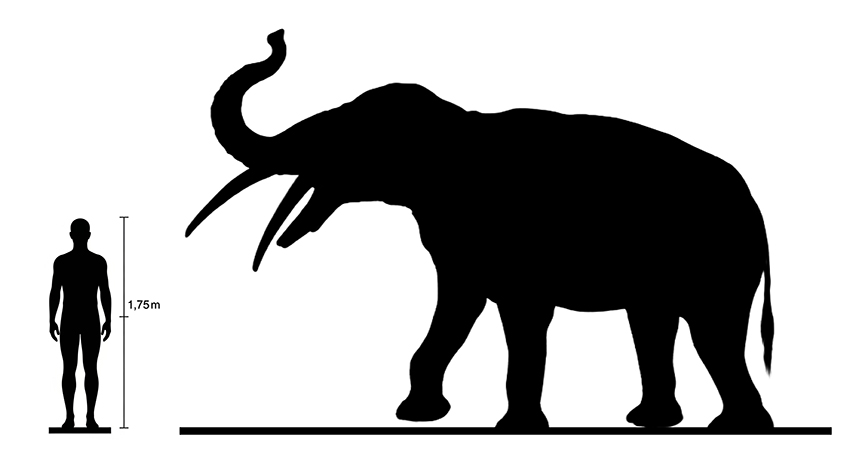Last updated: 4th August 2025
Extinct Animals: Gomphothere
Discover the ancient relative of the elephant with four tusks, that lived during the Ice Age.
Gomphothere (Peg-toothed Beast)
 Gomphothere
Gomphothere
Generative AI Notification: Some elements of this image have been created or enhanced using AI technology. To find out how we create all our prehistoric animals, click here.
What is a Gomphothere?
Gomphotheres were ancient relatives of today’s elephants that lived millions of years ago. These ascinating creatures roamed across North and South America, Africa, and parts of Eurasia before becoming extinct. Like mammoths and modern elephants, gomphotheres were large, gentle giants with long trunks and tusks.
How big were Gomphotheres?
Gomphotheres came in many sizes, with some as big as modern elephants and others a bit smaller. The largest could reach up to 4 metres tall at the shoulder and weigh as much as 4 to 5 tonnes—about the same as a big lorry!
What did Gomphotheres eat?
Gomphotheres were herbivores, meaning they ate only plants. Their diet included leaves, twigs, fruits, grasses, and bark. Some had special-shaped jaws and teeth to help them eat different types of plants, depending on where they lived.
Gomphothere appearance
- Large bodies with four sturdy legs
- Long trunks, similar to those of elephants
- Tusks: many had two on the top jaw and two shorter ones on the lower jaw
- Some had flat, shovel-shaped lower tusks, perfect for digging or scooping plants
 Gomphothere appearance
Gomphothere appearance
Where did Gomphotheres live?
Fossils show that gomphotheres lived on many continents, including North and South America, Africa, and Eurasia. They thrived in forests, woodlands, and even grasslands, wherever there was plenty of food and water.
When did Gomphotheres live?
Gomphotheres first appeared about 12 million years ago and survived until as recently as 10,000 years ago. This means they were still around during the last Ice Age and might have lived alongside early humans!
Interesting facts
- Gomphotheres are close cousins of mammoths and today’s elephants.
- Some species had four tusk, two on top and two on the bottom!
- They used their trunks and tusks to grab food, dig up plants, and even strip bark from trees.
- The name “gomphothere” means “peg-toothed beast,” because of their unique teeth.
- Gomphotheres became extinct about 10,000 years ago, possibly due to climate change and hunting by early humans.

Gomphothere Facts
Pronounced: GOM-foh-theer
Name Means: "Peg-Toothed Beast" (from Greek)
Length: Up to 4 metres (13 feet)
Height: Up to 4 metres (13 feet) at the shoulder
Weight: Around 4,000 to 5,000 kilograms (8,800 to 11,000 pounds)
Diet: Herbivore (Leaves, twigs, fruits, grasses, and bark)
Time: Miocene to the end of the Pleistocene Epoch (about 12 million to 10,000 years ago)
Fossils Found: North and South America, Africa, and Eurasia
Which family of animals did Gomphothere belong to?
They were part of the family Elephantidae, making them close relatives of modern elephants.
 Gomphothere size comparison
Gomphothere size comparison
What other animals lived at the same time as Gomphothere?
They lived alongside wooly rhinos, giant ground sloths (Megatherium), and early human populations, who often hunted them for food and resources.
Gomphothere FAQ
Q1: What is a Gomphothere?
A1. A Gomphothere is an extinct animal that looked a lot like an elephant. It had a long trunk and tusks, but its body and teeth were a bit different.
Q2. Were Gomphotheres dinosaurs?
A2. No, they were not dinosaurs. Gomphotheres were mammals and lived millions of years after the dinosaurs went extinct.
Q3. How big were Gomphotheres?
A3. Some Gomphotheres were as big as modern elephants, while others were smaller. They could weigh up to 4 tons!
Q4. What did Gomphotheres eat?
A4. They were herbivores, which means they ate plants. They used their trunks and tusks to grab leaves, twigs, and grass.
Q5. Where did Gomphotheres live?
A5. Gomphotheres lived in many places, including North America, South America, Africa, and Eurasia.
Q6. What made Gomphotheres different from elephants?
A6. Gomphotheres had four tusks instead of two—two on the top and two on the bottom! Their teeth were also shaped differently.
Q7. When did Gomphotheres live?
A7. They lived from about 20 million years ago until around 10,000 years ago, during the Ice Age.
Q8. Did humans ever see Gomphotheres?
A8. Yes! Early humans may have hunted Gomphotheres for food. Some fossils have been found near ancient human tools.
Q9. Why did Gomphotheres go extinct?
A9. Scientists think they went extinct because of climate changes and human hunting after the Ice Age ended.
Q10. How do scientists know about Gomphotheres?
A10. Scientists study fossils, which are the bones and teeth left behind. These fossils help us learn what Gomphotheres looked like and how they lived.
You may also be intrested in:
- Extinct Animals: A-Z
- Dinosaurs: A-Z
Tags: How big was Gomphothere, Gomphothere size, where did Gomphothere live, how tall was Gomphothere, what does Gomphothere mean, Gomphothere facts
Previous: Gastornis
Up next: Hyaenodon
© 2012 science-resources.co.uk. All rights reserved | Design by W3layouts
Extinct Animals: Gomphothere
Discover the ancient relative of the elephant with four tusks, that lived during the Ice Age.
Gomphothere (Peg-toothed Beast)
 Gomphothere
Gomphothere
Generative AI Notification: Some elements of this image have been created or enhanced using AI technology. To find out how we create all our prehistoric animals, click here.
What is a Gomphothere?
Gomphotheres were ancient relatives of today’s elephants that lived millions of years ago. These ascinating creatures roamed across North and South America, Africa, and parts of Eurasia before becoming extinct. Like mammoths and modern elephants, gomphotheres were large, gentle giants with long trunks and tusks.
How big were Gomphotheres?
Gomphotheres came in many sizes, with some as big as modern elephants and others a bit smaller. The largest could reach up to 4 metres tall at the shoulder and weigh as much as 4 to 5 tonnes—about the same as a big lorry!
What did Gomphotheres eat?
Gomphotheres were herbivores, meaning they ate only plants. Their diet included leaves, twigs, fruits, grasses, and bark. Some had special-shaped jaws and teeth to help them eat different types of plants, depending on where they lived.
Gomphothere appearance
- Large bodies with four sturdy legs
- Long trunks, similar to those of elephants
- Tusks: many had two on the top jaw and two shorter ones on the lower jaw
- Some had flat, shovel-shaped lower tusks, perfect for digging or scooping plants
 Gomphothere appearance
Gomphothere appearance
Where did Gomphotheres live?
Fossils show that gomphotheres lived on many continents, including North and South America, Africa, and Eurasia. They thrived in forests, woodlands, and even grasslands, wherever there was plenty of food and water.
When did Gomphotheres live?
Gomphotheres first appeared about 12 million years ago and survived until as recently as 10,000 years ago. This means they were still around during the last Ice Age and might have lived alongside early humans!
Interesting facts
- Gomphotheres are close cousins of mammoths and today’s elephants.
- Some species had four tusk, two on top and two on the bottom!
- They used their trunks and tusks to grab food, dig up plants, and even strip bark from trees.
- The name “gomphothere” means “peg-toothed beast,” because of their unique teeth.
- Gomphotheres became extinct about 10,000 years ago, possibly due to climate change and hunting by early humans.

Gomphothere Facts
Pronounced: GOM-foh-theer
Name Means: "Peg-Toothed Beast" (from Greek)
Length: Up to 4 metres (13 feet)
Height: Up to 4 metres (13 feet) at the shoulder
Weight: Around 4,000 to 5,000 kilograms (8,800 to 11,000 pounds)
Diet: Herbivore (Leaves, twigs, fruits, grasses, and bark)
Time: Miocene to the end of the Pleistocene Epoch (about 12 million to 10,000 years ago)
Fossils Found: North and South America, Africa, and Eurasia
Which family of animals did Gomphothere belong to?
They were part of the family Elephantidae, making them close relatives of modern elephants.
 Gomphothere size comparison
Gomphothere size comparison
What other animals lived at the same time as Gomphothere?
They lived alongside wooly rhinos, giant ground sloths (Megatherium), and early human populations, who often hunted them for food and resources.
Gomphothere FAQ
Q1: What is a Gomphothere?
A1. A Gomphothere is an extinct animal that looked a lot like an elephant. It had a long trunk and tusks, but its body and teeth were a bit different.
Q2. Were Gomphotheres dinosaurs?
A2. No, they were not dinosaurs. Gomphotheres were mammals and lived millions of years after the dinosaurs went extinct.
Q3. How big were Gomphotheres?
A3. Some Gomphotheres were as big as modern elephants, while others were smaller. They could weigh up to 4 tons!
Q4. What did Gomphotheres eat?
A4. They were herbivores, which means they ate plants. They used their trunks and tusks to grab leaves, twigs, and grass.
Q5. Where did Gomphotheres live?
A5. Gomphotheres lived in many places, including North America, South America, Africa, and Eurasia.
Q6. What made Gomphotheres different from elephants?
A6. Gomphotheres had four tusks instead of two—two on the top and two on the bottom! Their teeth were also shaped differently.
Q7. When did Gomphotheres live?
A7. They lived from about 20 million years ago until around 10,000 years ago, during the Ice Age.
Q8. Did humans ever see Gomphotheres?
A8. Yes! Early humans may have hunted Gomphotheres for food. Some fossils have been found near ancient human tools.
Q9. Why did Gomphotheres go extinct?
A9. Scientists think they went extinct because of climate changes and human hunting after the Ice Age ended.
Q10. How do scientists know about Gomphotheres?
A10. Scientists study fossils, which are the bones and teeth left behind. These fossils help us learn what Gomphotheres looked like and how they lived.
Tags: How big was Gomphothere, Gomphothere size, where did Gomphothere live, how tall was Gomphothere, what does Gomphothere mean, Gomphothere facts
Previous: Gastornis
Up next: Hyaenodon
© 2012 science-resources.co.uk. All rights reserved | Design by W3layouts